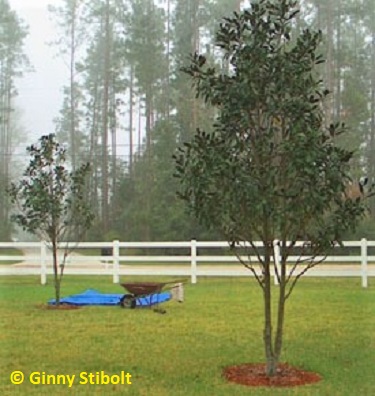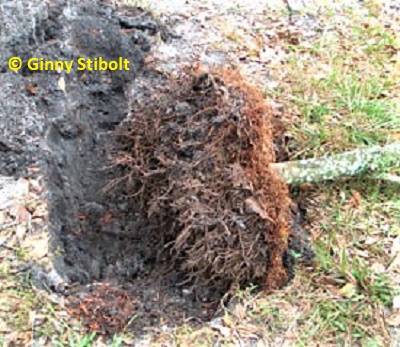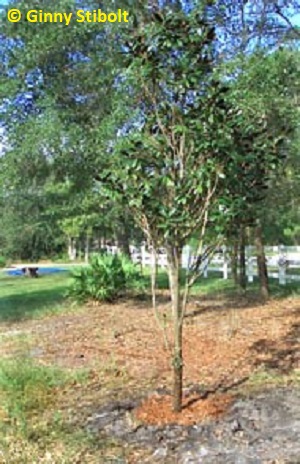|
Adventures of a Transplanted Gardener |
|||
My magnificent but messy magnolias
|
|||

These magnolias would have made a mess of the lawn. |
The grand southern magnolias (Magnolia grandiflora) seem to typify southern elegance for most people. Sip an icy mint julep on the verandah while sitting in your well-worn rocking chair in the cool, deep shade of an ancient southern magnolia with its fragrant white petals looking like a starched tuxedo shirt contrasted against those glossy forest green leaves. Yep, your northern friends would turn greener than those magnolia leaves. I know I always wanted to have my own magnolia when I lived in Maryland, but our lot was too small.
But wait! (Sound of record scratching...) Let’s look more closely at that image. There is nothing, and I mean nothing, growing under that spreading and shallow-rooted tree. The ground is littered with piles of leathery leaves and the woody cone-like flower cores that drop all year long. That elegant tree is mighty messy. My landscape professor used to say that the southern magnolia is a fabulous tree, but not in the middle of your yard because neither lawn nor bedding flowers will grow under it. Plant it in a location where its litter will not destroy lawns or gardens.
So back in June when we bought our house, I decided that the two young magnolias planted in the middle of our front lawn had to be moved. The house is only two years old and it looks like they might have purchased these trees at Home Depot where I noticed trees close to this size. One is about 15-feet and the other about 12. I assumed that since they’d been planted so recently that they would not have grown too far beyond the original root balls.
I pruned the roots and some of the low branches of each tree back in June so they’d have a chance to recover some before I transplanted them. To prune the roots, I cut down to the depth of the blade of a regular garden shovel all around at the edge of the mulched area. Then I repeated the trip around the circle with a long bladed spade. In the end, I’d made an 18-inch deep slice around both trees.
I also pruned the roots of another magnolia. The previous owner had planted a deciduous Asian magnolia too close to the house, and it had been trimmed as part of a hedge – poor thing.
I was happy with the location of two sweet bay magnolias (M. virginiana) growing at the edge of a clump of oaks in the front yard. This lovely smaller magnolia often gets lost in the shuffle when compared to its more glorious relative. Its leaves and highly fragrant flowers are about half the size of the southern magnolia’s, but this tree is a lot neater. A deciduous tree in its northern range, it keeps its leaves through the winter here in Florida. The sweet bay, also called the swamp magnolia, is often found growing in standing water. Both species are native to Florida, but the range of the sweet bay extends north into Pennsylvania while southern magnolia’s range extends only to the northern border of North Carolina. Southern magnolias are widely planted much farther north with special cold-tolerant cultivars.
When fall came with its cooler weather, it was time to move the four magnolias. The two southern magnolias in the middle of the yard were first. I decided to plant them out by the front fence at the edge of the oaks where they’d get good sun and have enough space to do what they wanted. This way we can still enjoy these glorious trees, but not have to deal with their litter in the lawn.
 The magnolias were planted less than 2 years ago, but still were hard to move. |
The first step was to dig holes in the new location twice as deep as the estimated root mass. Then I filled the bottom of the holes with pond muck to provide some nutrients and to slow down the drainage in the sandy soil. You could use leaves, mulch or other humus-rich material if you don’t have a pond that needs cleaning. Then I scraped off the mulch from around the trunk, re-cut the roots at the edge of the mulch line and dug out soil from under the dense mass of surface roots. In order not to make a mess on the grass, and to retain as much soil as possible for refilling in the hole, I placed the soil on a tarp. The tarp was later used to transport the trees to their new location.
Because the trees are so big, I called in my husband to help. We tipped each tree and its roots up and out of the hole. We both dug some more to retain as many of the roots as possible. None of the roots seemed to be any thicker than an inch or so. With a lot of effort, especially for the 15-foot tree, we rolled each one on its side and onto the tarp. Then, like a couple of field mules pulling a plow, we dragged them to the new holes. The holes needed reshaping once we tried to fit the root masses into them because they were larger than estimated.

A magnolia in its new spot. |
We flooded the holes as we filled in the dirt, sand, more pond muck and mulch around the edges of the roots to make sure that there’d be no big air pockets. After we made sure each tree was vertical, we tamped down the soil along the edges of the surface root mass and built a berm of soil to hold any water. I’ve hand irrigated them daily while waiting for significant rainfall. I’m not used to such a dry fall.
After tackling these big trees I went after the Asian magnolia (probably Magnolia x soulangeana). It has purple flowers, but we got here too late in the season to figure out its species. I’ll look at what Home Depot carries and I’m sure I’ll find it there. Finally, an easy transplant job, but it’ll be many years before it recovers from its harsh pruning to look like the elegant tree it could be. Magnolias just shouldn’t be pruned as part of a hedge.
With most of their root hairs torn off during transplant, the trees have a more difficult time absorbing water. They’ll each get a good deep watering each day for a few weeks. With all the transplants done within a few days, the extra watering chores are combined. I felt like the elephant girl in the circus lugging endless buckets of water to her wards.
(Update: the Asian magnolia struggled for a few years in its new site, but it died. I babied the two magnolias transplanted out into the front meadow area and they have thrived. But now, I wish I'd left them where they were and removed the lawn instead. I would have added a bunch of native azaleas, palmettos, beautyberries, coonties and some beautiful native muhly grass to create a native garden and haven for birds. The magnolias out in the meadow are too far away to really appreciate.)
Ginny Stibolt is a life-long gardener, a botanist, a naturalist, and a garden writer. You may contact her or read more of her articles posted on her website: www.greengardeningmatters.com.
Copyright Ginny Stibolt

